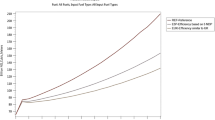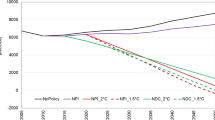Abstract
In this study, we develop a new integrated assessment model called the BET model (Basic Energy systems, Economy, Environment, and End-use Technology Model). It is a multi-regional, global model based on Ramsey’s optimal growth theory and includes not only traditional end-use technologies but also advanced end-use technologies such as heat-pump water heaters and electric vehicles. Using the BET model, we conduct simulations and obtain the following results. (1) Advanced end-use technologies have an important role in containing carbon prices as well as GDP losses when GHG (greenhouse gas) constraints are stringent. (2) Electrification based on energy services progresses rapidly in scenarios with stringent GHG constraints. This is because electricity can be supplied by various methods of non-fossil power generation, and advanced end-use technologies can drastically improve energy-to-service efficiencies. The BET’s results indicate the importance of analyses that systematically combine environmental constraints, end-use technologies, supply energy technologies, and economic development.





Similar content being viewed by others
Explore related subjects
Discover the latest articles and news from researchers in related subjects, suggested using machine learning.References
Akimoto K, Sano F, Oda J, Homma T, Rout UK, Tomoda T (2008) Global emission reductions through a sectoral intensity target scheme. Clim Pol 8:S46–S59
Bosetti V, Carraro C, Galeotti M, Massetti E, Tavoni M (2006) WITCH: a world induced technical change hybrid model. The Energy J, Special Issue Hybrid Model 27:13–38
Brooke A, Kendrick D, Murows A (1992) GAMS release 2.25: a user’s guide. Scientific Press Inc
Criqui P, Mima S, Vigular L (1999) Marginal abatement costs of CO2 emission reductions, geographical flexibility and concrete ceilings: an assessment using the POLES model. Energy Policy 27:585–601
Edmonds J, Wilson T, Marshall W, Weyant J (2006) Electrification of the economy and CO2 emissions mitigation. Environ Econ Policy Stud 7:175–203
UK Energy Research Centre (2010) UK MARKAL Model: documentation. http://www.ukerc.ac.uk/support/ESMMARKALdocs08, accessed 8 August 2012
IEA (2010) Extended world energy balances 2010. International Energy Agency
Kainuma M, Matsuoka Y, Morita T (2000) The AIM/end-use model and its application to forecast Japanese carbon dioxide emissions. Eur J Oper Res 122:416–425
Kriegler E, Weyant J, Blanford G, Clarke L, Tavoni M, Krey V, Riahi K, Fawcett A, Richels R, Edmonds J (2013) The role of technology for achieving climate policy objectives: overview of the EMF 27 study on global technology and climate policy strategies. doi:10.1007/s10584-013-0953-7
Kyle P, Clarke L, Smith SJ, Kim S, Nathan M, Wise M (2011) The value of advanced end-use energy technologies in meeting U.S. climate policy goals. Energy J 32(Special Issue):61–87
Leimbach M, Toth FL (2003) Economic development and emission control over the long term: the ICLIPS aggregated economic model. Clim Change 56:139–165
Leimbach M, Bauer N, Baumstark L, Edenhofer O (2010) Mitigation cost in a globalize world: climate policy analysis with REMIND-R. Environ Model Assess 15:155–173
Loulou R, Labriet M (2008) ETSAP-TIAM: the TIMES integrated assessment model Part I: model structure. Comput Manag Sci 5:7–40
Loulou R, Goldstein G, Noble K (2004) Documentation for the MARKAL family of models. Energy Technology Systems Analysis Programme
Manne AS, Richels RG (1992) Buying greenhouse insurance: the economic costs of CO2 emission limits. MIT Press
Manne A, Mendelsohn R, Richels R (1995) MERGE - A model for evaluating regional and global effects of GHG reduction policies. Energy Policy 23:17–34
Messner S, Schrattenholzer L (2000) MESSAGE–MACRO: linking an energy supply model with a macroeconomic module and solving it iteratively. Energy 25:267–282
Negishi T (1960) Welfare economics and existence of an equilibrium for a competitive economy. Metroeconomica 12:92–97
Nordhaus WD (1994) Managing the global commons: the economics of climate change. MIT Press
Richels RG, Blanford GJ (2008) The value of technological advance in decarbonizing the U.S. economy. Energy Econ 30:2930–2946
Schrattenholzer L (1981) The energy supply model MESSAGE. Research report RR-81-31, International Institute for Applied Systems Analysis (IIASA)
Sugiyama M (2012) Climate change mitigation and electrification. Energy Policy 44:464–468.
Sugiyama M, Akashi O, Wada K, Kanudia A, Li J, Weyant J (2013) Energy efficiency potentials for global climate change mitigation. Clim Change (this issue). doi:10.1007/s10584-013-0874-5
Tsutsui J (2011) SEEPLUS: a simple online climate model. J Jpn Soc Civ Eng, Ser G (Environ Res) 67:134–149
Weyant JP (ed.) (1999) The costs of the Kyoto Protocol: a multi-model evaluation. Energy J Special Issue 20
Weyant JP (ed.) (2004) EMF 19 alternative technology strategies for climate change policy. Energy Econ 26:501–755
Weyant JP, de la Chesnaye FC, Blanford GJ (2006) Overview of EMF-21: multigas mitigation and climate policy. Energy J Special Issue 27(3):1–32
Acknowledgment
We greatly appreciate the kindness of the MERGE group to make a version of the code available online, which helped us develop the BET model.
Author information
Authors and Affiliations
Corresponding author
Additional information
This article is part of the Special Issue on “The EMF27 Study on Global Technology and Climate Policy Strategies” edited by John Weyant, Elmar Kriegler, Geoffrey Blanford, Volker Krey, Jae Edmonds, Keywan Riahi, Richard Richels, and Massimo Tavoni.
Electronic supplementary material
Below is the link to the electronic supplementary material.
ESM 1
(DOCX 127 kb)
Rights and permissions
About this article
Cite this article
Yamamoto, H., Sugiyama, M. & Tsutsui, J. Role of end-use technologies in long-term GHG reduction scenarios developed with the BET model. Climatic Change 123, 583–596 (2014). https://doi.org/10.1007/s10584-013-0938-6
Received:
Accepted:
Published:
Issue Date:
DOI: https://doi.org/10.1007/s10584-013-0938-6




